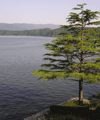October
Japanese lake record improves radiocarbon dating

New results may help archaeologists and climate scientists refine age estimates by hundreds of years.
A 'time capsule' Japanese lake will help make radiocarbon dating more precise and accurate, new research has shown.
The work at Lake Suigetso, led by Newcastle University, could be used to refine estimates of the ages of organic material by hundreds of years. Archaeologists, for example, may be able to further specify the timing of the extinction of Neandertals or the spread of modern humans into Europe. And, climate scientists may better understand the chains of events that led to the advance and retreat of the ice sheets during the last glacial period.
“In short, this is a realization of a 20-year-long Japanese dream,” said Takeshi Nakagawa of Newcastle University. Professor Nakagawa, from the University's school of Geography, Politics and Sociology, is one of the primary authors of the study and leader of the Lake Suigetsu (SG06) project.
The research appears in the 19 October 2012 issue of the journal Science, which is published by AAAS, the nonprofit, international science society.
“The new results offer an important refinement of the atmospheric radiocarbon record and place the radiocarbon timescale on a firmer foundation,” said Jesse Smith, Senior Editor at Science.
In Lake Suigetsu, a layer of tiny, relatively light-colored algae called diatoms blankets the floor each year, followed by a layer of darker sediments. The lake bottom is very still and anoxic, so these layers have remained undisturbed over tens of thousands of years. A series of cores drilled through these layers now provides an exquisitely preserved record of the past 52,800 years.
Researchers recognized as early as 1993 that sediment cores from Lake Suigetsu might be useful for radiocarbon dating, but the initial efforts encountered technical problems.
Radiocarbon, or C-14, is a naturally occurring, radioactive isotope of carbon that decays at a steady rate. Researchers can calculate the age of an object based on how much radiocarbon it contains relative to its stable cousin, C-12. But, there are several factors that complicate this calculation, since the amounts of radiocarbon in the environment -- and incorporated into growing organisms -- can vary from year to year and between different parts of the global carbon cycle.
Adjusting for these natural fluctuations in radiocarbon is a process called calibration and requires long, known-age records with associated radiocarbon data. Some of the longest and most important radiocarbon records come from marine sediments or cave formations. However, these need to be corrected using a variety of assumptions about how radiocarbon levels change in ocean water and groundwater.
The terrestrial sediment record now presented by Christopher Bronk Ramsey of the University of Oxford and colleagues requires no such correction. The radiocarbon in the leaf fossils preserved in the sediment comes directly from the atmosphere and is not subject to the same processes that affect radiocarbon in marine sediments or cave formations.
The only other direct record of atmospheric carbon comes from tree rings and extends to 12,593 years ago. The Lake Suigetsu record stretches back 52,800 years, extending the direct radiocarbon record by more than 40,000 years. Other, indirect radiocarbon records also reach back to roughly 50,000 years ago.
“In most cases the radiocarbon levels deduced from marine and other records have not been too far wrong. However, having a truly terrestrial record gives us better resolution and confidence in radiocarbon dating,” said Bronk Ramsey. “It also allows us to look at the differences between the atmosphere and oceans and study the implications for our understanding of the marine environment as part of the global carbon cycle.”
To construct their radiocarbon record from Lake Suigetsu, Bronk Ramsey and colleagues measured radiocarbon from terrestrial plant fragments spaced throughout the core. They also counted the light and dark layers throughout the glacial period to place the radiocarbon measurements in time. Many of the layers were too fine to be distinguished by the naked eye, so the researchers used a microscope, as well as a method called X-ray fluorescence that identifies chemical changes along the core.
A record of year-to-year changes, such as a sediment core, must be “anchored” in time by assigning some part of it an absolute age. The researchers did this by matching the first 12,200 years of their record with the tree-ring record, a well-established record that begins in the present.
Bronk Ramsey and colleagues also lined up segments of their record with those of other records from the same time periods and generally found good agreement.
"Because of the unique combination of a complete radiocarbon record and terrestrial paleoclimate data, Suigetsu can be a benchmark against which other records can be compared,” said Professor Nakagawa. “From a palaeoclimate perspective, this radiocarbon dataset will also allow very high precision direct correlation between Suigetsu and other terrestrial climate record. This allows us to see how changes in climate in different parts of the world relate to one another – and particularly where there are leads and lags. Information like this is very useful for studying climate mechanisms.”
“Although this record will not result in major revisions of dates, for example in archaeology, there will be changes in detail that are of the order of hundreds of years,” said Bronk Ramsey. “Such changes can be very significant when you are trying to look at human responses to climate, often dated by other methods, for example through the Greenland ice cores. So, a more accurate calibrated time-scale will allow us to answer questions in archaeology, which previously we have not had the resolution to address.”
Researchers generally use a composite record called IntCal to determine the ages of objects based on their radiocarbon measurements. The IntCal record incorporates data from multiple sources, including marine records, speleothem and tree rings, and is updated periodically. Bronk Ramsey and colleagues anticipate that their Suigetsu data will be incorporated into the next iteration of the IntCal compilation, to be released in a few months.
published on: 18 October 2012
